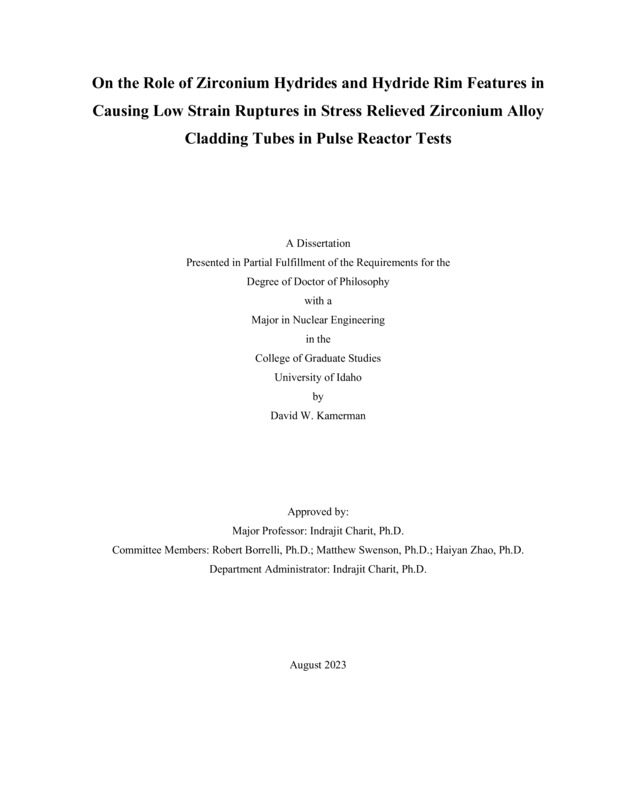On the Role of Zirconium Hydrides and Hydride Rim Features in Causing Low Strain Ruptures in Stress Relieved Zirconium Alloy Cladding Tubes in Pulse Reactor Tests
Kamerman, David. (2023-08). On the Role of Zirconium Hydrides and Hydride Rim Features in Causing Low Strain Ruptures in Stress Relieved Zirconium Alloy Cladding Tubes in Pulse Reactor Tests. Theses and Dissertations Collection, University of Idaho Library Digital Collections. https://www.lib.uidaho.edu/digital/etd/items/kamerman_idaho_0089e_12654.html
- Title:
- On the Role of Zirconium Hydrides and Hydride Rim Features in Causing Low Strain Ruptures in Stress Relieved Zirconium Alloy Cladding Tubes in Pulse Reactor Tests
- Author:
- Kamerman, David
- ORCID:
- 0000-0002-2610-038X
- Date:
- 2023-08
- Program:
- Nuclear Engr & Industrial Mgmt
- Subject Category:
- Nuclear engineering
- Abstract:
-
Stress relieved zirconium alloys are the most prevalently used material to construct light water reactor fuel cladding tubes. Circumferential zirconium hydride features form in the metal matrix because of waterside corrosion, and at high exposures thick, ‘rim’ like features form on the cladding outer surface. During transient reactor pulse tests on high exposure fuel rods, they are prone to rupture at low cladding strain. These low strain ruptures are currently the most limiting failure mode for light water reactor fuel rods. The objective of this dissertation work is to better quantify the role of circumferential hydrides and hydride rim structures in causing these low strain ruptures. A novel way of artificially creating these prototypic hydride structures is developed and described. A novel method for creating a uniform, bi-axial, and strain-controlled load in the cladding tubes was achieved by programming an in-situ cladding hoop strain measurement into a feedback loop with a high-pressure pneumatic regulator on an internal pressure test. When these strain-controlled pressure tests were conducted on cladding tubes with hydride rims at low cladding temperatures, less than 150 C, the stress relieved zirconium alloy cladding tubes begin rupturing at very low strain with even modest concentrations of cladding hydrogen,. However, at higher temperatures of 150 C and above cladding ductility is remarkably improved and only cladding tubes with ~500 ppm of hydrogen or higher experience low strain ruptures. Another significant finding from the strain-controlled pressure testing is that the hydride rims always fractured at hoop stress levels below that which would have caused cladding yielding in a non hydrided sample.
- Description:
- doctoral, Ph.D., Nuclear Engr & Industrial Mgmt -- University of Idaho - College of Graduate Studies, 2023-08
- Major Professor:
- Charit, Indrajit
- Committee:
- Swenson, Matthew; Zhao, Haiyan; Borrelli, Robert
- Defense Date:
- 2023-08
- Identifier:
- Kamerman_idaho_0089E_12654
- Type:
- Text
- Format Original:
- Format:
- application/pdf
- Rights:
- In Copyright - Educational Use Permitted. For more information, please contact University of Idaho Library Special Collections and Archives Department at libspec@uidaho.edu.
- Standardized Rights:
- http://rightsstatements.org/vocab/InC-EDU/1.0/

